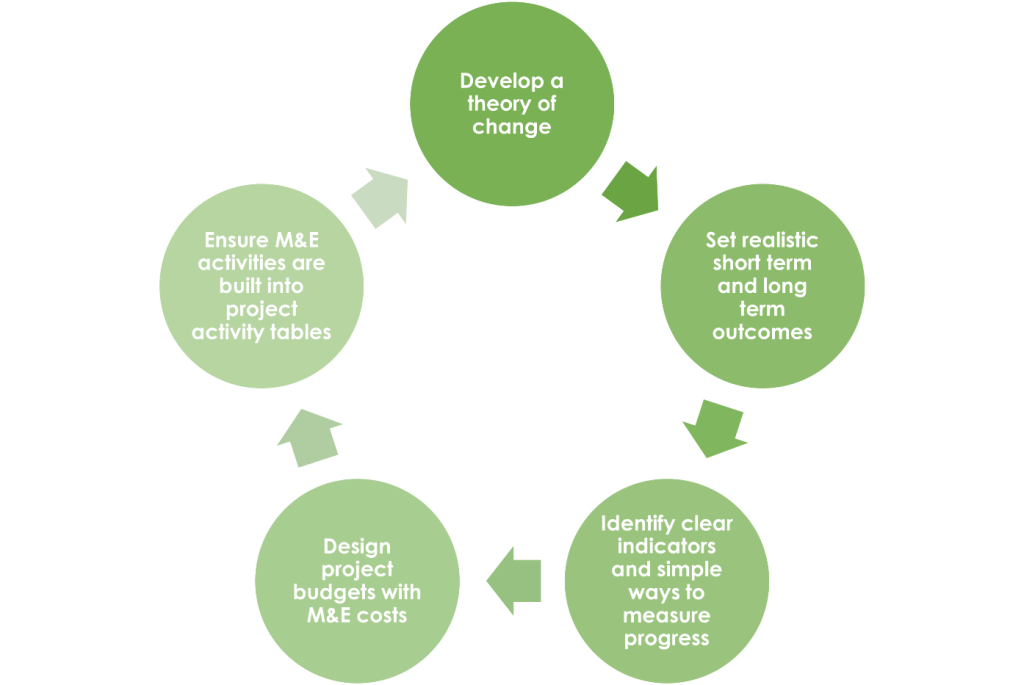You’ve started a new year refreshed from your summer break, ready to dive into work and suddenly a reminder pops up about the report your funder requires by the end of the month. It sends you into a spin – what will you write? Is there any data? How will you evaluate the project? Argh!
Demonstrating the impact of your work is an essential but often overlooked part of grant-seeking and project delivery. Monitoring and Evaluation (M&E) can seem like an island, isolated from the rest of the project and funding cycles. There is a general view that the only way organisations can deliver M&E is to engage an external expert who comes in at the end of a project to write up an evaluation.
So, how can you approach M&E differently in 2023?
The key to making M&E easy is to embed it into your project design, development and budgeting from the very beginning. We see organisations who are planning out their project to secure funding, however M&E is not part of their development process. Demonstrating that you’ve considered M&E when you’re applying for funding will show funders that your project planning is robust and underpinned by the impact that you want to create.
What are funders looking for?
Funders are focused on the social impact their funding will create, and for-purpose organisations want to create social impact. The magic happens when for-purpose organisations can tell the story of the social impact they are creating, from the funding they receive.
The Ian Potter Foundation is a leader in supporting organisations to effectively evaluate their projects and shared the importance of quality M&E.
“Measuring the social impact of grants helps recipient organisations to understand and communicate the social/economic value of their work. Measuring and reporting outcomes helps drive funding and increases competitiveness in the market.
With effective, shared measurement organisations can benchmark themselves. Indeed, funding sustained programs that can consistently demonstrate long-term positive outcomes is often seen as the holy grail of strategic philanthropy.
To put it more simply, if our recipients look good, we look good.”
Five ways to embed Measuring and Evaluation into project design and development
Organisations that build M&E into the early stages of project planning will be on the front foot and well positioned to tell the story of their impact to funders through the reporting and acquittal process.
Here are five ways you can do this:
1. Develop a theory of change
The most fundamental piece of your M&E work is your theory of change, or logic model, and should be a key part of your project planning. While the finished document or end diagram is incredibly useful, the process in getting to that completed model is where the real value lies.
The process of creating your theory of change forces you to understand the environment in which you are working. You need to know the external factors that will influence your interventions or programs, as well as being able to clearly articulate the outcomes you want to achieve and how they relate to your mission.
Developed correctly, the process engages your whole organisation, your stakeholders and the target groups of your programs. The result is a shared resource that guides your work, holds you accountable to stakeholders and allows for continuous improvement, as you compare your outcomes evidence against your theory of change.
2. Set realistic goals for short term and long term outcomes
Your theory of change process will help you to identify what the project’s outcomes are. When applying for grants, it’s important to have realistic goals for measurement of outcomes. One of the key criteria that funders will base their decision on is the outcomes you commit to. If you commit to a complex evaluation with large sample sizes, this is their expectation in the reporting.
There is a tendency to confuse outputs with outcomes. A project’s outcomes will be the change that will occur as a result of the project’s interventions. Think about how your project will create change for the individual, as well change for their families and the community. For longer term outcomes, think about changes at a social and structural level.
3. Identify clear indicators and simple ways to measure progress
Setting indicators is best done when you are developing your project outcomes. Think about and discuss what success and impact looks like. What indicators would demonstrate success? Match them to your outcomes. Importantly, make sure they are realistic, clear and achievable.
Measurement tools don’t need to be overly complicated. Evaluation plans need to be relative to the project. For example, outlining the use of pre and post testing of participants and having a control group is probably over doing it for a small project.
Existing organisational data is often a valuable and untapped resource and should be one of the first options for measuring success. If additional data needs to be collected, then ensure this is set up from the very beginning of the project.
4. Design project budgets with M&E costs
Funders are increasingly aware of the need to support organisations to effectively evaluate their projects. Instead of M&E being a stand-alone line item in a budget, consider the different resources required to effectively set up and evaluate your project.
For example, are additional staff hours required to collect and analyse data? Consider workshop costs if you’re holding evaluation workshops or focus groups. Is there a cost in designing a survey through an online survey platform? Ensure your budget includes costs against every activity. Even if some costs are being covered by your organisation, you still need to account for the project, completely.
5. Ensure M&E activities are built into project activity tables
Finally, when developing project activities and implementation charts, ensure that the activities related to your M&E are included so that this work is ongoing and not forgotten. This includes the activities required to establish a baseline, ongoing data collection and analysis, as well as the iterative process of reviewing how the project is progressing and making changes as needed.
Building this into project plans will also ensure that when you touch base with your funder at regular times during the funding cycle, you’ll have information to share on how the project is progressing.

The five steps to embedding M&E in your projects
The good news is that you don’t have to do it alone! The more you engage your whole organisation in the planning and collection of this information, the more useful the results will be for you and your funders.
Importantly, remember to always talk to your funders about your challenges with M&E, they are there to support you and want to hear from you. The results are just as important to them for proving their impact as they are to your organisation.
Strategic Grants can support you along your measuring and evaluation journey and set you up with the skills and knowledge to embed M&E into the DNA of your organisation. Get in touch to find out more.
